When choosing between an MRI and a CT scan, consider your medical needs. MRI excels at detailed images of soft tissues like the brain, joints, and nerves, making it ideal for complex conditions. CT scans are faster and better for detecting fractures, bleeding, or infections, especially in emergencies. Understanding when each is used helps guarantee you get the most accurate diagnosis—more insights below reveal which option suits your situation best.
Key Takeaways
- MRI is preferred for detailed soft tissue imaging, such as brain, joints, and nerves, due to its high contrast resolution.
- CT is faster and ideal for emergency situations like fractures, internal bleeding, and trauma assessment.
- MRI avoids radiation exposure, making it suitable for repeated scans and pregnant patients needing neurological or soft tissue evaluation.
- CT provides sharper images of bones, dense tissues, and lung structures, useful in detecting fractures and lung conditions promptly.
- The choice depends on urgency, tissue detail needs, and safety considerations: use CT for quick diagnosis, MRI for detailed soft tissue assessment.
Understanding the Technology Behind MRI and CT Scans
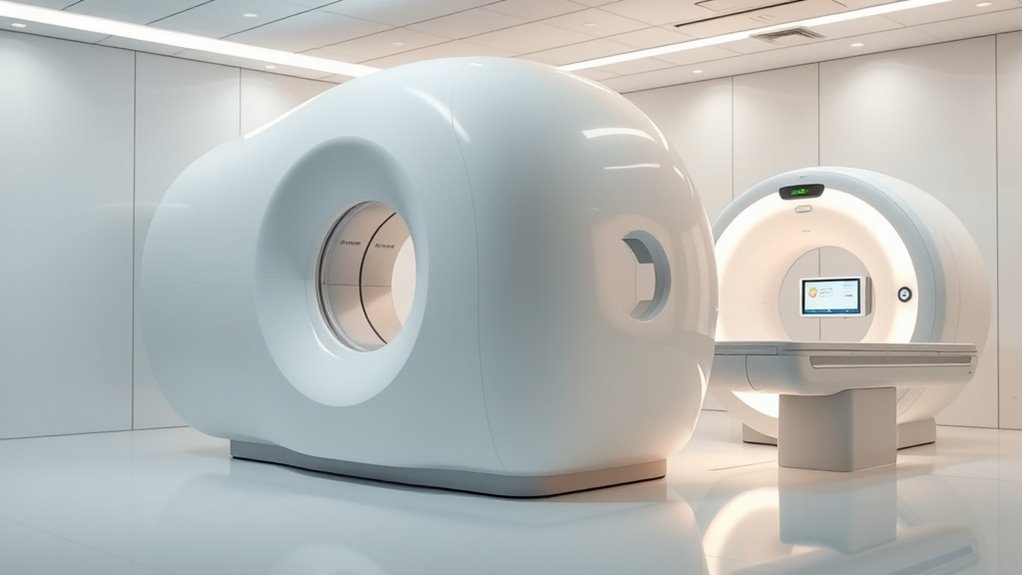
Magnetic Resonance Imaging (MRI) and Computed Tomography (CT) scans use different technologies to produce detailed images of the body’s interior. MRI employs powerful magnets and radio waves to generate images by aligning hydrogen atoms in your body, then detecting signals as they realign. It’s especially good at capturing soft tissues like the brain, muscles, and ligaments. CT scans, on the other hand, use X-ray beams rotating around your body to create cross-sectional images. These images are assembled by a computer, highlighting differences in tissue density. The technology behind each scan influences their strengths and limitations. While MRI relies on magnetic fields and radiofrequency signals, CT depends on ionizing radiation. Both methods provide unique insights into your health, depending on what your doctor needs to see. Understanding the differences between MRI and CT scans can help in making informed healthcare decisions.
Key Differences in Image Quality and Detail
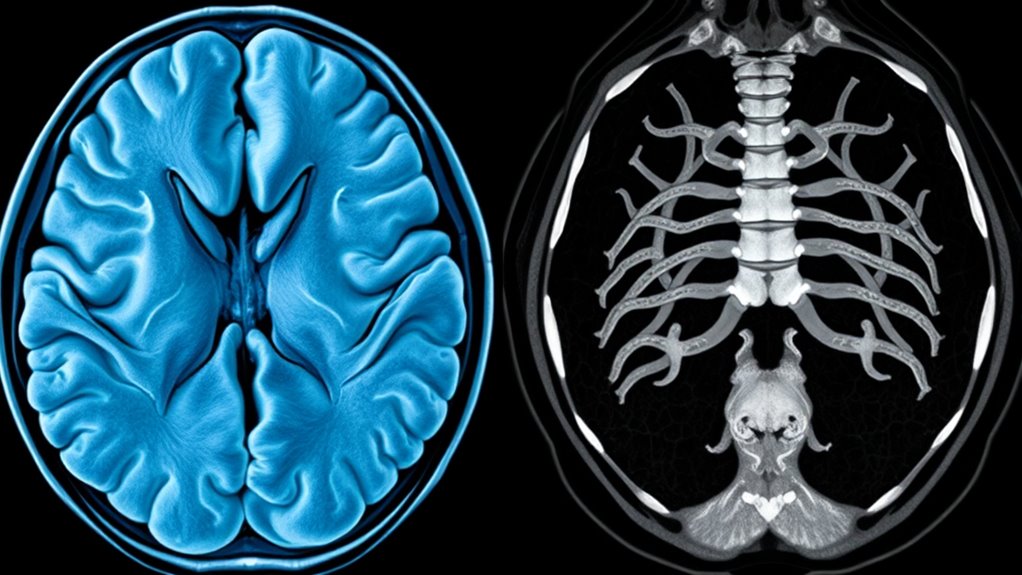
MRI and CT scans produce images with distinct differences in quality and detail due to their underlying technologies. MRI uses strong magnetic fields and radio waves, resulting in highly detailed images of soft tissues like the brain, muscles, and ligaments. You’ll notice MRI images provide excellent contrast, making subtle differences in tissue types clear. In contrast, CT scans use X-rays to create images, which excel at capturing dense structures like bones and detecting acute injuries or bleeding. While CT images may lack the soft tissue contrast of MRI, they offer sharper visualization of bone fractures and calcifications. Overall, MRI delivers superior soft tissue detail, whereas CT provides clearer images of bone and quick detection of certain pathologies. Your choice depends on the specific structures and conditions you need to evaluate. Butter’s artistic influence highlights how different imaging techniques can emphasize various tissue characteristics, similar to how butter art accentuates textures and colors in cultural expressions.
Speed and Duration of the Scanning Process
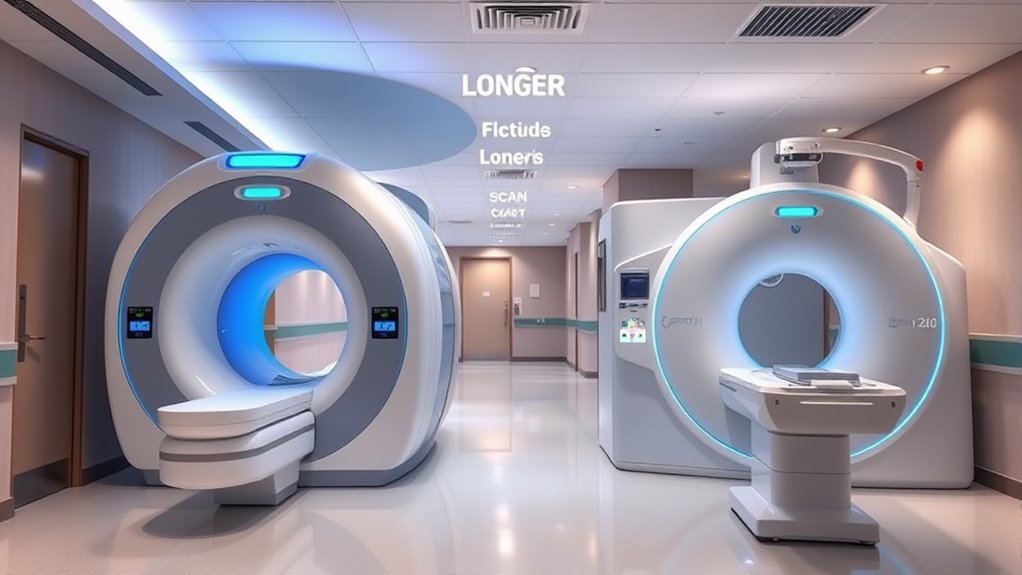
You’ll notice that MRI scans take longer to complete, which can be challenging in urgent situations. In contrast, CT scans provide rapid imaging, making them ideal for emergency cases. For routine assessments, the longer duration of MRI might be worth the detailed images it offers.
MRI: Longer Scanning Times
Although MRI scans provide detailed images, they typically take longer to complete compared to other imaging methods. You might find yourself in the scanner for 30 to 60 minutes, depending on the area being examined. The process involves multiple steps, including positioning, acquiring images from different angles, and sometimes administering contrast agents. The longer duration allows for high-resolution images, which are essential for detailed analysis of soft tissues, joints, and the brain. Additionally, data-driven strategies can help optimize the scanning protocols to improve efficiency without compromising image quality. However, this extended time can be uncomfortable, especially if you’re claustrophobic or have difficulty remaining still. Unlike quicker scans, MRI requires patience and stillness to make certain that clear images. Despite the longer process, the detailed results often justify the extra time needed.
CT: Rapid Image Acquisition
How quickly can a CT scan provide images? Typically, you’ll get detailed results within minutes. Unlike MRI scans, which can take longer, CT scans are fast and efficient, making them ideal for urgent situations. A standard CT scan can capture multiple images in just a few seconds, reducing your time in the scanner. Here’s a comparison highlighting the speed benefits:
| Feature | CT Scan | MRI Scan |
|---|---|---|
| Image Acquisition Time | 1-10 seconds per scan | 15-60 minutes per scan |
| Suitability for Urgency | High, ideal for emergencies | Lower, more time-consuming |
This rapid process helps doctors quickly assess injuries or conditions, ensuring swift diagnosis and treatment. Additionally, contrast enhancement can be used during CT scans to improve image clarity when needed.
Emergency vs. Routine Scans
Emergency scans are designed to be quick, providing immediate information when time is critical, whereas routine scans prioritize detailed imaging and can take considerably longer. In urgent situations, speed is essential to diagnose life-threatening conditions quickly. A well-coordinated industry trend often influences the choice of scan based on technological capabilities and clinical protocols. Here’s what you need to know:
- Speed: Emergency scans, like rapid CTs, often take just a few minutes, helping you get quick results.
- Duration: Routine scans, such as MRI, can last 30 minutes or more, focusing on detailed images.
- Purpose: Emergency scans aim for rapid assessment, while routine scans provide exhaustive insights for ongoing treatment.
Choosing between them depends on urgency and the detail needed for accurate diagnosis. Your healthcare team considers these factors to determine the most appropriate scan type.
Safety Considerations and Patient Risks

When choosing between MRI and CT scans, safety considerations and patient risks play an essential role. MRI scans use strong magnetic fields and radio waves, so they are safe for most patients but can be risky if you have metal implants, pacemakers, or certain electronic devices. In contrast, CT scans involve ionizing radiation, which increases your long-term cancer risk, especially with repeated exposure. Pregnant women are advised to avoid CT scans unless absolutely necessary due to radiation concerns. Additionally, some patients may experience claustrophobia during MRI or allergic reactions to contrast agents used in both procedures. You should discuss your medical history with your healthcare provider to determine the safest option, considering any implants, allergies, or pregnancy status. Understanding imaging safety is crucial for making informed decisions about diagnostic procedures.
Appropriate Uses for MRI Scans
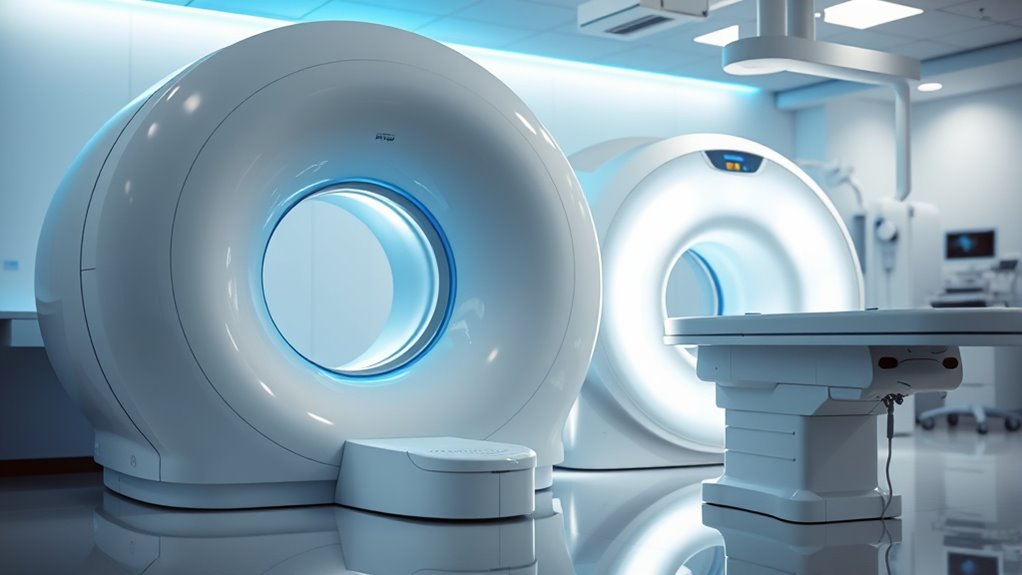
MRI scans are particularly effective for imaging soft tissues, making them ideal for detecting injuries or abnormalities in muscles, ligaments, and joints. They are also the preferred choice for examining the brain and spinal cord, providing detailed insights into neurological conditions. Understanding these specific uses can help you determine when an MRI is the best option for your diagnostic needs. Additionally, MRI technology can be useful for assessing tissue abnormalities that other imaging methods might miss.
Soft Tissue Imaging
MRI is particularly effective for soft tissue imaging because it provides detailed, high-contrast images that help distinguish among muscles, ligaments, cartilage, and nerves. This makes it ideal for diagnosing injuries or abnormalities in these structures. When considering soft tissue issues, MRI is often the first choice because it offers superior clarity over other imaging techniques. Here are some common uses:
- Detecting ligament tears or sprains in joints like the knee or ankle.
- Identifying cartilage damage in joints, such as meniscus tears.
- Visualizing nerve entrapments or inflammation affecting soft tissues.
This precision allows you to plan appropriate treatments or surgeries more effectively. MRI’s ability to differentiate soft tissues clearly makes it invaluable for detailed assessment of complex anatomy, guiding accurate diagnosis and management. Remote work principles, such as flexible scheduling, can also enhance the overall effectiveness of diagnostic procedures by accommodating patient needs and reducing appointment stress.
Brain and Spinal Cord
The detailed soft tissue images provided by MRI are invaluable for examining the brain and spinal cord. If you suspect a tumor, multiple sclerosis, or infections, MRI gives clear, high-resolution images that help pinpoint abnormalities. It’s especially useful for detecting subtle changes in brain tissue, such as lesions or inflammation. When evaluating spinal cord issues like herniated discs, cord injuries, or tumors, MRI provides detailed views that other scans can’t match. Unlike CT, MRI doesn’t use radiation, making it safer for repeated imaging. If your doctor needs precise information about neurological conditions, an MRI is often the best choice. It helps guide diagnosis, treatment planning, and monitoring of neurological diseases with exceptional clarity. Additionally, vetted imaging practices ensure the safety and accuracy of MRI scans for neurological assessments.
Common Applications for CT Scans
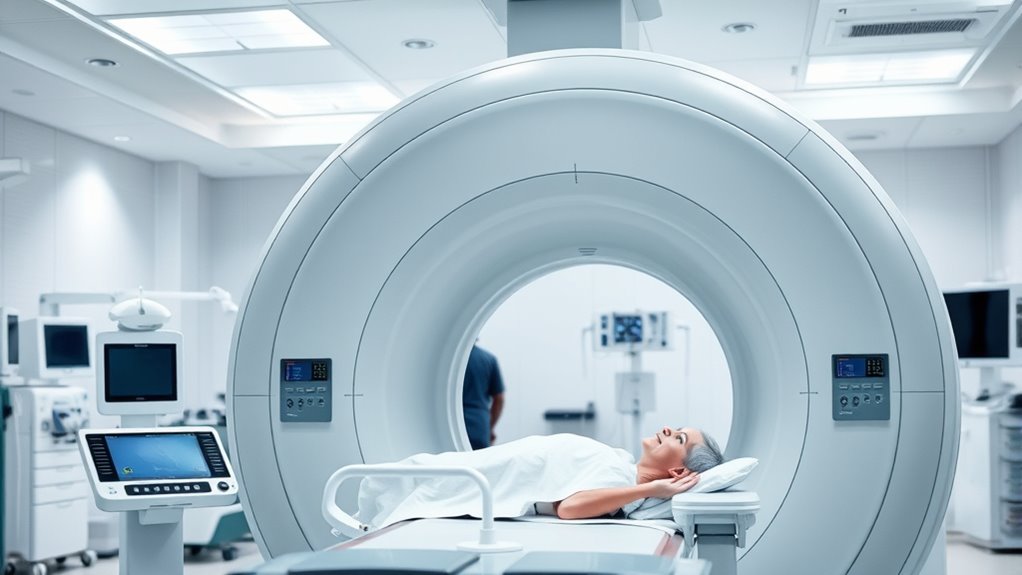
Computed Tomography (CT) scans are widely used in medical settings to quickly and accurately diagnose a variety of conditions. You’ll find them helpful in emergency situations, such as detecting fractures or internal bleeding. They’re also essential for evaluating cancers, providing detailed images to guide treatment plans. Additionally, CT scans are effective for identifying infections or inflammation, especially in organs like the abdomen or lungs. The speed and clarity of CT imaging make it a go-to tool for urgent diagnostics and complex cases. Whether appraising traumatic injuries, monitoring disease progression, or planning surgeries, CT scans deliver rapid, detailed insights that help healthcare providers make informed decisions efficiently. Understanding the asset division of medical information can also aid in managing healthcare costs and insurance claims related to imaging.
Situations Favoring One Modality Over the Other

Choosing between MRI and CT depends on the specific medical situation. If you need detailed images of soft tissues like the brain, spinal cord, or joints, an MRI is usually preferable because of its superior contrast resolution. MRI is also better for detecting tumors, inflammation, or neurological conditions. On the other hand, if you require quick imaging for trauma, fractures, or bleeding, a CT scan is often the better choice due to its speed and ability to visualize bone structures clearly. CT scans are also more suitable for evaluating lung and chest issues, such as infections or pulmonary embolisms. Your healthcare provider will consider these factors, along with patient safety and urgency, to determine which modality best fits your specific diagnosis.
Making the Right Choice: Factors to Consider
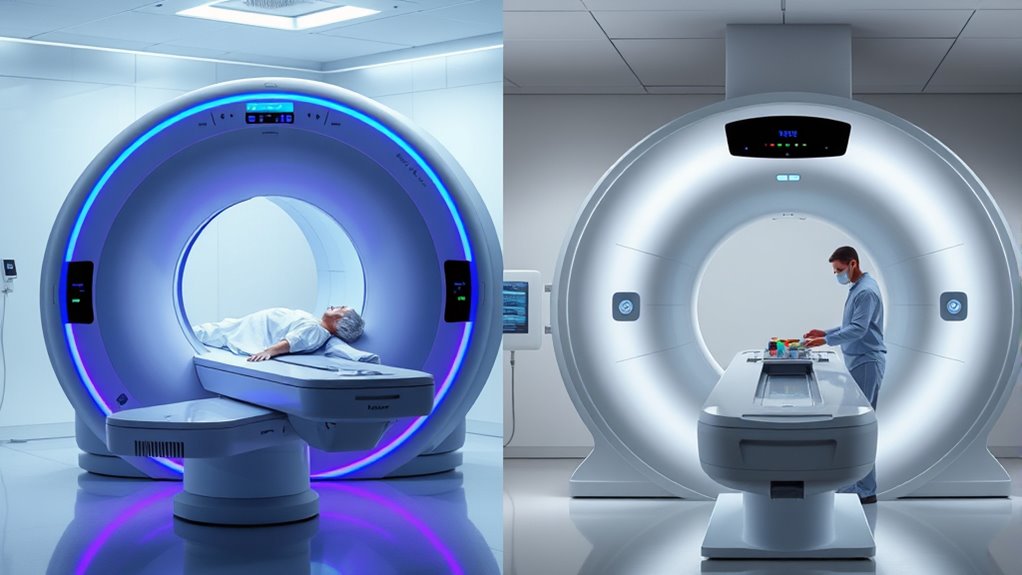
When deciding between MRI and CT, you need to weigh several important factors to guarantee the best possible outcome. First, consider what you’re looking to diagnose. MRI excels at soft tissue detail, ideal for brain, joints, or spinal cord issues, while CT is faster and better for detecting bone fractures or lung problems. Second, think about safety concerns. If radiation exposure is a concern, MRI offers a safer alternative, especially for pregnant patients. Third, evaluate urgency and accessibility. CT scans are typically quicker and more widely available, making them suitable for emergency situations. By appraising these factors—diagnostic needs, safety, and timing—you can choose the most appropriate imaging method for your specific case.
Frequently Asked Questions
How Do Cost and Insurance Coverage Compare Between MRI and CT Scans?
You might wonder about the costs and insurance coverage for MRI and CT scans. Generally, MRIs tend to be more expensive than CT scans because they use advanced technology and longer procedures. Insurance coverage varies; some plans cover both fully, while others may require higher co-pays or have limits. It’s best to check with your provider beforehand to understand your specific coverage and potential out-of-pocket costs.
Are There Any Specific Age Restrictions for MRI or CT Procedures?
Ever wonder if age limits your scans? You’re usually safe, but there are some restrictions. MRI scans often avoid patients with metal implants, which are more common as you age. CT scans are generally suitable for all ages but are used cautiously in children due to radiation exposure. Doctors consider your health, age, and specific needs to determine the safest option, ensuring your comfort and safety come first.
How Do Contrast Agents Differ Between MRI and CT Scans?
You might wonder how contrast agents differ between MRI and CT scans. For MRI, contrast agents are typically gadolinium-based, which enhance soft tissue visibility and are usually safe for most people, but caution is needed for those with kidney issues. For CT scans, contrast agents are iodine-based, providing clearer images of blood vessels and organs. Each type is chosen based on the specific diagnostic needs and patient health considerations.
Can Patients With Metal Implants Safely Undergo MRI?
If you have metal implants, your safety during an MRI depends on the type of implant. Some implants are MRI-safe, while others can pose risks or be affected by the magnetic field. You should always inform your healthcare provider about your implants, so they can determine if an MRI is safe for you or suggest alternative imaging options. Never assume your implant is MRI-compatible without professional confirmation.
What Are the Environmental Impacts of MRI and CT Equipment?
You might wonder about the environmental impacts of MRI and CT equipment. MRI machines consume significant electricity and require cooling systems that use water and energy, contributing to resource use. CT scanners also use considerable power and generate radiation waste, which needs proper disposal to avoid environmental harm. Both devices have manufacturing and disposal impacts, so reducing unnecessary scans and improving energy efficiency can minimize their ecological footprint.
Conclusion
Choosing between MRI and CT depends on your specific needs. For instance, if a friend had a detailed brain scan to diagnose a tumor, an MRI provided clearer images without radiation. Similarly, if you need a quick injury assessment after a fall, a CT offers fast results. Understanding these differences helps you and your doctor select the best scan for your situation, ensuring accurate diagnosis and safe, effective care.








